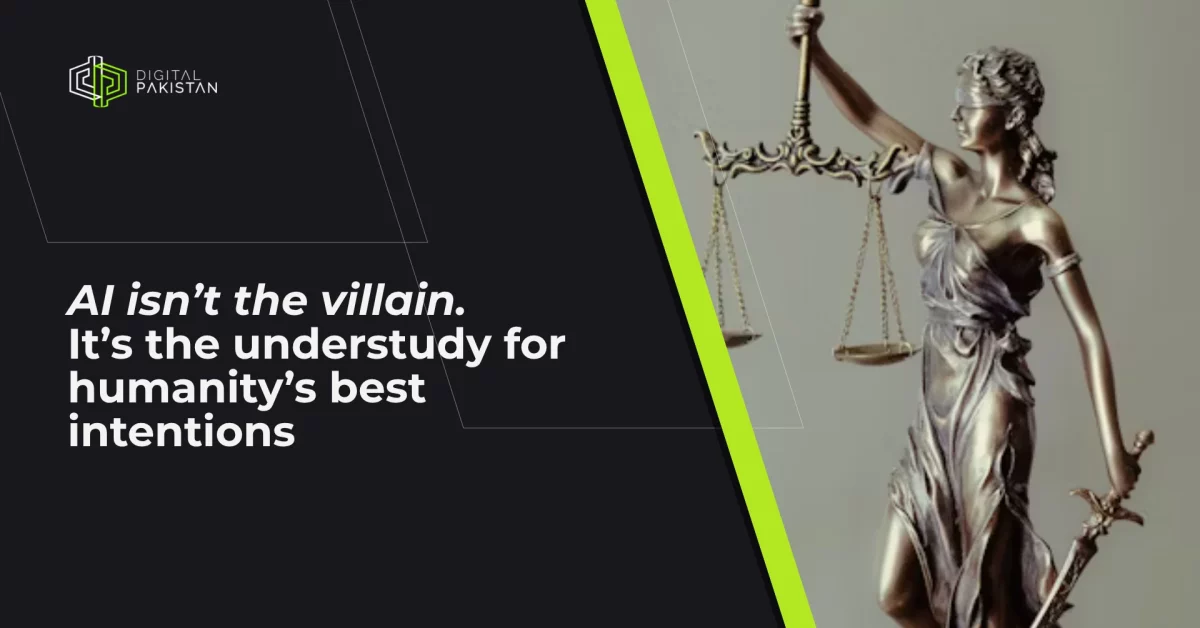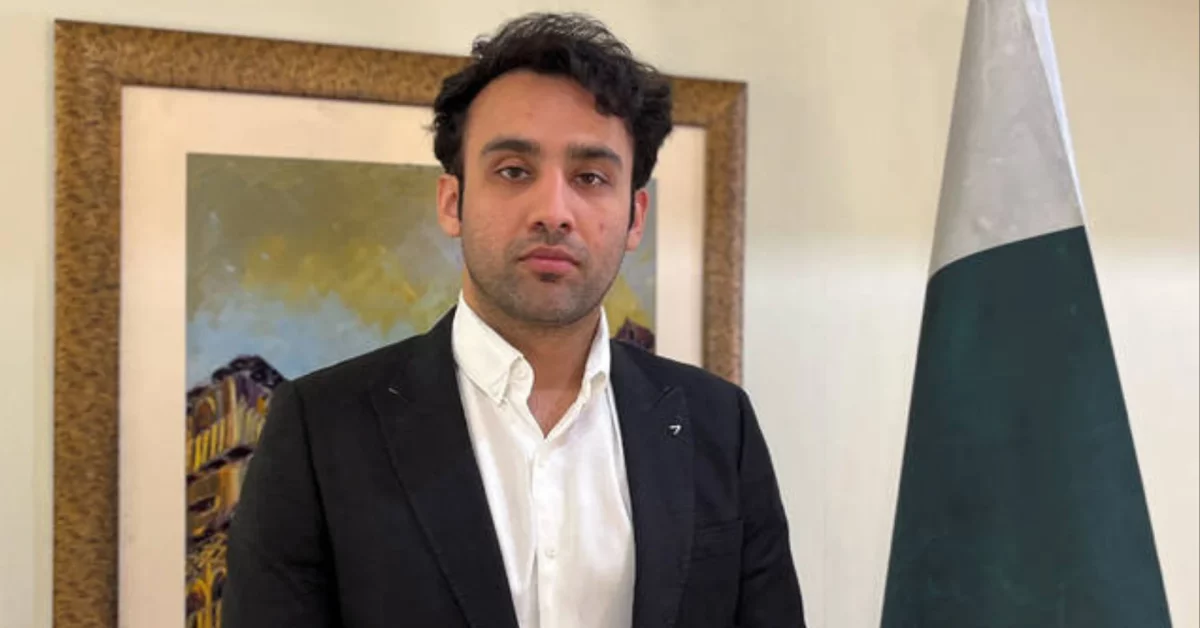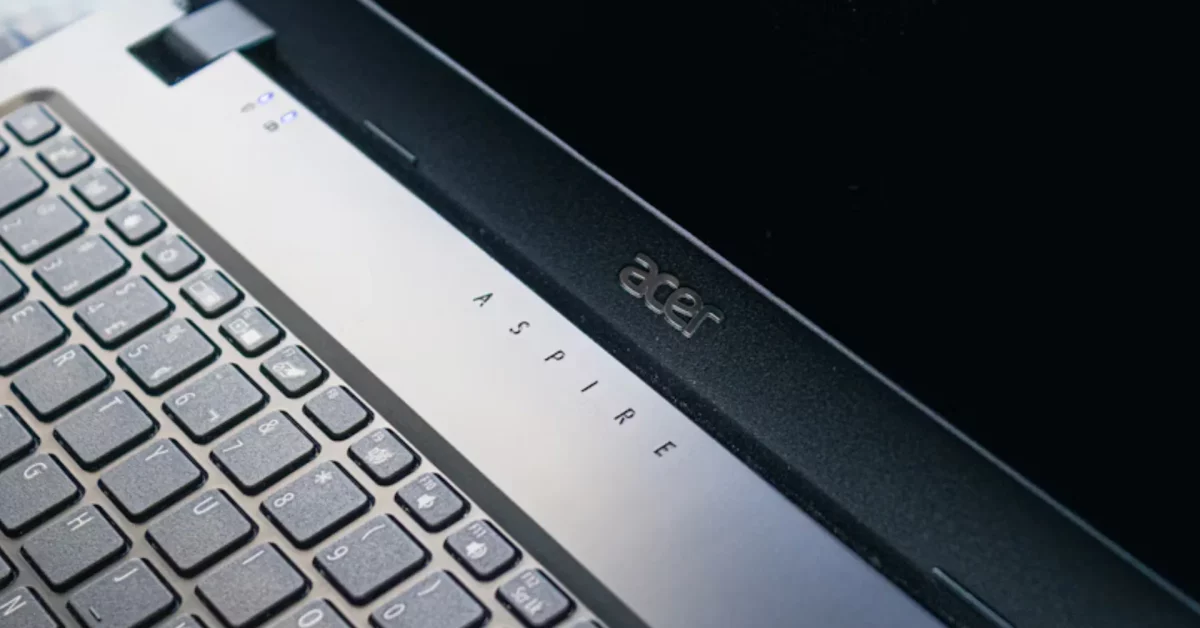
Pakistan’s Blue Economy: Charting a $100 Billion Future
November 5, 2025
Pakistan to Announce 5G Spectrum Policy Soon
November 6, 2025“All rise! The court is now in session. Is the defense ready?”
“Ready, your honor.”
“The defense may now present its case.”
By now, the jury is likely privy to the apocalyptic prophecies with regards to, as the opposition would call it, ‘the viral infestation of artificial intelligence’, and how we should all be preparing our underground bunkers for doomsday. Through tirades of criticisms, the opponents have exposed their blind spots to the real artificial intelligence advantages for humanity.
We sat in this very court, listening to the opposition go on and on about how AI will steal our jobs, plagiarize our souls, and render humanity obsolete. Artists rail against it. Writers form digital picket lines. Academics pen manifestos declaring the death of authenticity, creativity, and human uniqueness itself.
The opposition’s primary line of contention is that artificial intelligence represents an existential threat to everything that makes us human. To question this narrative is to commit intellectual heresy, to betray your species at the altar of technological determinism.
We have to admit, the tales of woe are rather compelling and we respect their stance. In fact, we have something in common with the opposing party: we both want what’s best for the future of human race. Therefore, defending artificial intelligence won’t be such a challenge. In the span of only a few years, AI has proved its unmatched efficacy time and time again.
This is not a love letter to Silicon Valley. Nor is it a naive dismissal of legitimate concerns about algorithmic bias, labor exploitation, or corporate consolidation of power. Rather, it’s an uncomfortable proposition: that much of our AI anxiety is rooted in nostalgia, gatekeeping, and a deeply human inability to distinguish between change and catastrophe.
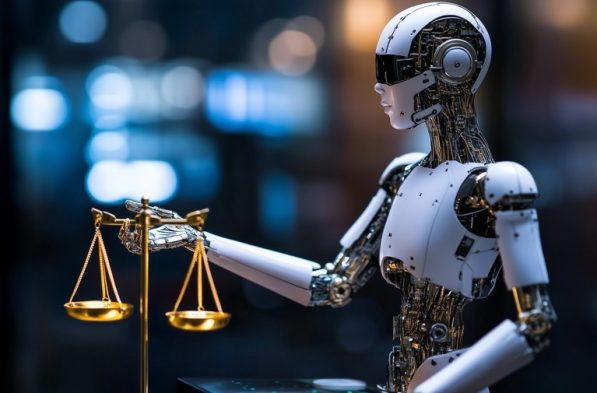
Photo: Julia/Adobe Stock
Perhaps the time has come to play devil’s advocate-not because AI is in any way deserving of uncritical celebration, but because our hysteria itself demands scrutiny. After all, what does it say about the strength of our convictions if we cannot abide an argument on behalf of the very thing of which we are afraid?
Exhibit A: The First Responder to Everyone’s Cry for Help
We live in a world where human expertise is both valuable but fundamentally bound by time, geography, and capacity. The teacher who inspires you has thirty other students. The mentor who can change your trajectory is unavailable precisely when you need them most. This isn’t a failure of human compassion; this is the mathematics of finite resources meeting infinite need.
AI does not replace these irreplaceable connections; it steps in and fills the gaps when these connections are unable to. At 3 AM, when questions consume your mind and every human you know is rightfully asleep, AI is awake. When you’re trying to wrap your head around concepts before tomorrow’s exam and office hours are days away, it’s there.
When you need to understand medical terminology before your next appointment or to learn skills outside institutional hours, AI responds instantly, patiently, and without taking up any of a human expert’s precious time on preliminary questions. It amplifies human capacity, not diminishes human value.
To the overwhelmed parent, to the isolated rural student, to the anxious learner needing multiple explanations before they feel ready to ask a person: AI builds the scaffolding that will make human connection more meaningful when it finally happens.
Despite of what the opponent’s AI myths would have the jury believe, the motive behind this mission was never to between human help and artificial assistance. It’s the first responder that stabilizes until human wisdom, irreplaceable and essential, arrives to do what only humans can: truly understand, genuinely empathize, and authentically connect.

Illustration depicting AI helping humanity, symbolizing a seamless partnership where technology extends human potential through trust and collaboration
Image source: Shinsei Motions/iStock
Exhibit B: Betterments and Breakthroughs as Far as the Eyes Can See
While the opposition grieves the loss of a hypothesized future, AI is relentlessly solving problems that have plagued us for generations. AI detects cancers in medical imaging scans far more accurately than human radiologists can, at stages when intervention can save lives.
It hastens drug discovery by compressing decades of research into months and predicts the structures of proteins that unlock treatments for diseases once thought incurable. For patients in remote regions where specialists may not be available, AI-aided diagnostic tools make preliminary assessments that catch conditions before they become catastrophic.
The doctor is still needed with expertise no AI can replace, but AI does make sure more people get to see that doctor on time. Climate catastrophe demands solutions at scales and speeds that human cognition alone can’t meet. AI optimizes energy grids, reducing waste and integrating renewable sources with an unprecedented level of efficiency.
It models complex climate systems, identifying points of intervention we’d never calculate by hand. It designs materials for carbon capture, monitors deforestation in real time, and predicts extreme weather events with enough warning to save lives.
Artificial intelligence productivity gains translate to human liberation when wielded correctly. AI automates the tedious, the repetitive, the mind-numbing tasks that drain our days-data entry, scheduling, preliminary research, routine coding. This isn’t job theft; it’s cognitive emancipation.
The architect spends less time on calculations, more on vision. The researcher bypasses mundane analysis to focus on interpretation. The writer escapes formatting hell to concentrate on craft. When implemented ethically, AI doesn’t eliminate work-it eliminates the parts of work that eliminate our humanity.
Education, for so long straightjacketed by standardized approaches and resource scarcity, finally bends toward individual need. AI tutors adapt to learning styles in real time, pinpointing precisely where comprehension falters and adjusting explanations accordingly. Students who would get lost in traditional classrooms receive one-on-one attention at scale.

AI solving problems across healthcare, research, and education, bridging human expertise with intelligent innovation for a better future.
Image source: https://databasetown.com/how-ai-is-changing-the-future-of-work/
Language barriers dissolve. Complex subjects become accessible to those once excluded by geography, economics, or learning differences. Teachers, freed from rote instruction, can finally do what they became educators to do: inspire, mentor, guide.
The job displacement argument ignores history’s pattern: technology destroys specific jobs while creating completely new industries. AI spawns roles that didn’t exist five years ago: prompt engineers, AI ethicists, machine learning ops specialists, synthetic data creators. Apart from direct AI jobs, the efficiency gains enable expansions elsewhere.
Healthcare providers hire more nurses when AI handles administrative burdens. Creative agencies grow when designers complete projects faster. The economy doesn’t contract; it reshapes. AI accessibility improvements justify its very existence.
AI-powered tools give voice to the nonverbal, sight to visually impaired persons by way of advanced object recognition, mobility to the paralyzed by neural interfaces. The deaf communicate seamlessly with sign language translation. Dyslexic readers comprehend texts converted to optimal formats.
These are not mere conveniences but dignities restored, worlds opened, and isolations ended. The improvements are empirical, measurable, and current. AI is not a promise far away or an abstract threat; it is present, functional, improving everything in every domain of human concern.
We can debate philosophical implications while acknowledging practical realities: people are learning better, working smarter, and accessing opportunities beyond their reach. The question isn’t whether AI creates value. The evidence is overwhelming. The question is whether we’ll let our fear mongering blind us to benefits that are already materializing before our eyes.
Exhibit C: Ethical Anxieties and Distrust in Human Intent
Ladies and gentlemen of the jury, it’s the moment you’ve been waiting for. The elephant is in the room when you realize that the opposition’s war is not with AI but with themselves. Their arguments all align under a singular theme: humans cannot be trusted with their own vices and ultimate power.
Well, if the shoe fits, wear it. Why should AI take the fall and face chastisement for human folly? Every civilization in history has been affronted by a similar fate. Rebellions, revolutions and change is inevitable. The difference is that, this time around Dr. Frankenstein here has unleashed something which possess a perceived existential threat.
We request the court stenographer to note the emphasis on perceived.
But do you know what’s not different? The fact that when the revolution starts to go south and things slip out of hand, the once united break off in violent fighting, pointing fingers at each other rather than holding themselves accountable for their own wrongdoing. It’s the same old song and dance.
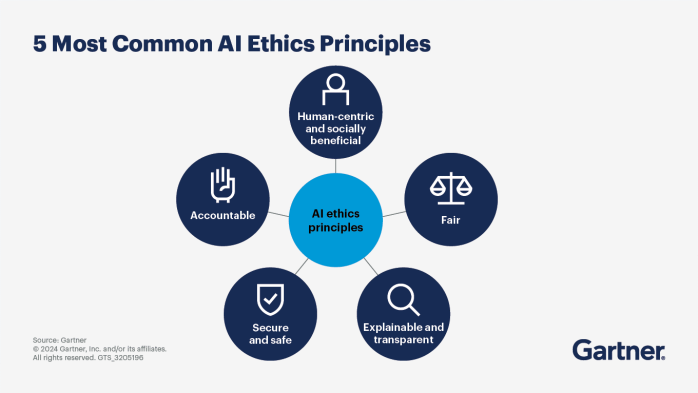
This image highlights the core pillars of AI ethics, emphasizing fairness, accountability, safety, transparency, and human-centric values.
Image source: https://www.gartner.com/en/articles/ai-ethics
If you don’t want AI to be your undoing, then do not use it that way. How does the opposition fail to understand that there are a myriad ethical techniques for implementing AI into human lives, and not wipe themselves out in the process.
If you don’t want to shoot yourself in the foot, don’t point the gun in that direction at all. Learn how to properly and ethically use your weapon first. If Prometheus gave fire to humankind, but forgot to teach them how to avoid self-incineration – please, judge for yourself, whose fault that is? The flame’s or the seat upon which Prometheus sits?
The framework for AI ethics already exist. We’re just too paralyzed by panic to apply them. Algorithmic decision-making transparency isn’t science fiction, it’s policy waiting to be enacted. Regulatory oversight of the deployment of AI in critical sectors is not impossible, it’s a choice we’re refusing to make.
The technology to use AI more ethically is already available. Bias detection algorithms that audit other algorithms. Privacy-preserving techniques that allow for AI functionality without data exploitation.
Human-in-the-loop systems that ensure critical decisions will never rest solely on silicon. Open-source models democratize, instead of concentrate, power. These are not fantasies, but tools gathering dust while we wring our hands about dystopian inevitability. Self-annihilation isn’t an AI problem, honorable jurors, it’s a governance problem.
It is a corporate accountability problem, a human greed problem masquerading as a technological one. We could mandate that AI systems serving public goods remain non-profit. We could require algorithmic impact assessments before deployment. We could enforce consequences for companies that prioritize profit over safety.
We could educate populations on AI literacy so that users understand what they are consenting to. We simply aren’t doing it. The opposition cries that AI will destroy us, then does nothing to prevent the destruction they prophesy. If you really believe AI presents an existential risk, then fight for regulation, oversight, and ethical implementation.
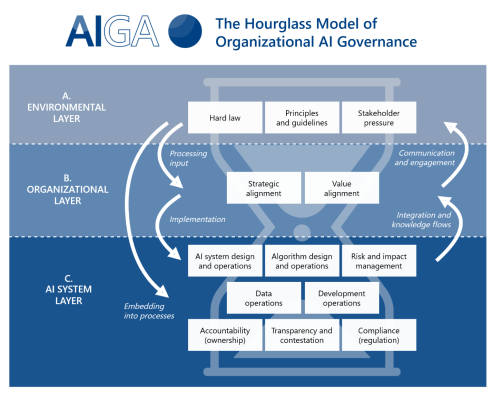
Image illustrating responsible AI development and governance
Image source: AI Governance Framework – Artificial Intelligence Governance and Auditing (AIGA) https://ai-governance.eu/
“Counsel, the court requests that the defense begin to wrap up its case.”
“Thank you, your honor. We’re moving to our closing statement”
Ladies and gentlemen of the jury, our opponent cannot hide from the fact that AI is here to stay. It is evolving fast, even as we speak. Not to absolve AI of scrutiny, but to redirect it where it belongs, toward ourselves. The opposition would have you believe we stand at the precipice of annihilation, that artificial intelligence is the harbinger of our obsolescence.
Yet every exhibit reveals the same truth: AI is neither savior nor destroyer. It is a mirror, reflecting back our intentions, our ethics, our capacity for wisdom or recklessness. The threat isn’t coded in algorithms; it’s embedded in human choice. We’ve always possessed the tools for our own undoing, nuclear weapons, environmental devastation, biological warfare.
AI is simply the latest addition to an arsenal we’ve been building since we first sharpened stones. AI’s trajectory depends entirely on whether we choose regulation over negligence, ethics over profit, collective responsibility over individual greed. The courtroom drama ends here. What happens next isn’t predetermined by silicon and code, it’s determined by whether we’re courageous enough to govern ourselves.
“The defense rests its case, your honor.”

